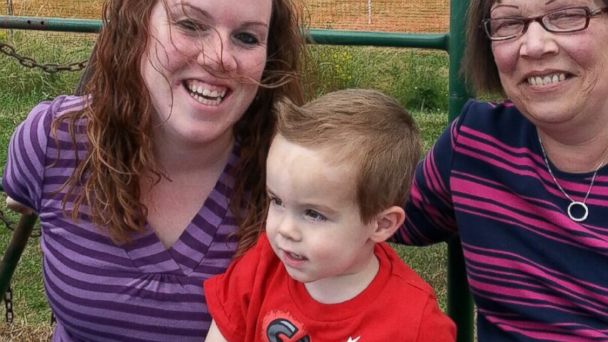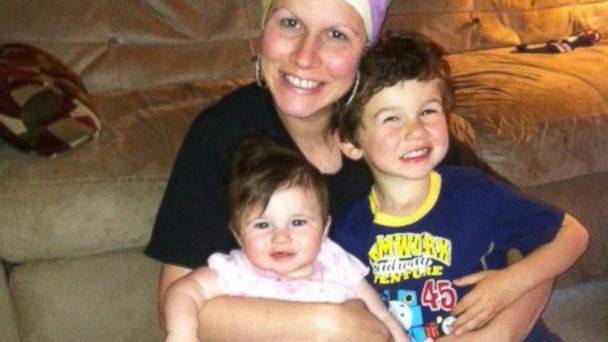One Gene, Three Women: A Family's Experience of Breast Cancer

Erin O'Keefe with her son Shaun and mother Josephine Jennings. O'Keefe opted for a preventive double mastectomy after testing positive for the BRCA1 gene test. Jennings has been diagnosed with breast cancer three times.

Tara Kenyon with her children Reese and Owen. Kenyon underwent 20 weeks of chemotherapy treatment after her double mastectomy.
The day that Tara Kenyon was driving her mother to a chemotherapy appointment was the same day doctors told her that she had breast cancer as well.
As the New Jersey women were in the car, Kenyon, 32, kept the news a secret from her mother, Josephine Jennings. The 58-year-old was going through breast cancer for the third time in her life.
What they shared, though, was more than just the disease. Kenyon, her sister, Erin O'Keefe, and their mother all tested positive for the BRCA1 gene test, giving them an 87 percent risk of developing breast cancer. Though Jennings found it "heartbreaking" that the gene, which had passed down through generations from her father's side of the family, was now impacting her daughters, she calls them "very brave" for how they chose to respond.
Josephine Jennings: "Rely on your family."
When she was diagnosed with breast cancer for the first time three decades ago, Jennings was only 29 years old. In the third month of her pregnancy with her second daughter, she found a lump near her underarm. What she thought was a cyst kept getting bigger. After the baby was born, the cyst was removed but was found to be masking a 10 cm tumor.
"I remember the surgeon and the nurse coming in to my room," said Jennings. "And the nurse was crying. I knew right away that I had cancer. When I asked if I would live, the surgeon shrugged his shoulders because he just didn't know."
Two days after a C-section to deliver daughter Erin, Jennings had a mastectomy and remained in the hospital three weeks longer. She got home a week before Christmas. What followed was six months of chemotherapy and 50 radiation treatments.
Jennings had another child the following June - perfectly healthy. But just after celebrating her fifth year of being cancer-free, at 34, she found a pea-sized lump on her breast. After a lumpectomy, she had six months of chemo and 30 radiation treatments.
For two decades, Jennings scheduled yearly mammograms and was free of cancer. But early last year, she found another small lump. Her doctors scheduled a mastectomy but then cancelled it when they found she had Stage IV breast cancer that had spread to her lung. After 18 months of chemotherapy, a CAT scan indicated her breast was clear of cancer. Her lung was mostly clear as well. Jennings' next step is asking her doctors about re-scheduling a mastectomy.
"Fear is an actual thing, but you got to think with your head," she said. "The doctor told me: 'Don't ever think you're dying of cancer. You're living with cancer.'"
Jennings said that advice and her family - husband Kevin, three children and three grandchildren - helped her through all the years of her disease.
"Rely on your family, that's where I got my strength from," said Jennings. "Their support and love is what got me through."
Tara Kenyon: "I knew in my gut it was cancer."
When Jennings got a positive result for her BRCA1 gene testing, her doctors advised that her daughters get tested as well.
Earlier this year, Tara Kenyon and her sister went to have their blood drawn for the test. One week later, Kenyon found a lump during a routine breast self-exam.
"I'd been fearful for a long time," said Kenyon. "I discovered it on a Saturday night and kept checking but it wasn't going away. It was hard and not moving. I knew in my gut it was cancer."
She told her husband on Sunday night and called her doctor first thing the next morning, who told her to get a mammogram and ultrasound, which she was able to schedule right away. During the procedure, the ultrasound technician kept going over the same spot and had a worried look on her face. The doctor then told Kenyon she had cancer.
"I broke down in tears and I was absolutely petrified," she recalled. "The vision I have of cancer is that this is the worst thing you can go through. I was completely devastated."
A surgeon did a needle biopsy two days later that confirmed the cancer. The doctor gave her treatment options: a lumpectomy, a mastectomy or a double mastectomy. Kenyon chose the last one, knowing that "I'm positive for the gene, I know it's just going to come back."
About a month after she first went for genetic testing, Kenyon was in the hospital for a nearly eight-hour surgery. It took her weeks to get back to her old self, during which her husband Tim - a Hodgkin's Lymphoma survivor himself - "was run ragged" caring for 6-month-old Reese and 3-year-old Owen.
Before she started 20 weeks of chemotherapy, Kenyon got her hair cut and donated it to "Locks of Love," the nonprofit group that provides hairpieces to disadvantaged children suffering from medical hair loss.
But she wasn't prepared for how tough it was to deal with the rest of her hair - shorn down to a buzz cut - falling out. She wore a headscarf.
"Now that I'm done with chemo, I'm experiencing a lot of fear," said Kenyon. "I'm grateful that I'm okay, but once you have cancer, it leaves a mark because it's such a trauma. When you're on treatment, you feel like you're fighting it."
Kenyon said her positive genetic test determined her choice to have a double mastectomy.
"If you find a lump or get tested positive, it doesn't mean everything is over," she said. "There is happiness and light through all of this. I think what makes you beautiful is how you go through a situation when you're almost at the wall. It's strength, courage and putting a smile on your face when you don't want to."
Erin O'Keefe: "If I had to do it again, I would."
You could say that Erin O'Keefe was born into the experience of breast cancer. She was a newborn when her mother was first diagnosed. At 29, she decided to find out if she was at a higher risk of developing the disease. The results of the genetic testing showed she was.
"I was devastated," said O'Keefe. "I cried. I thought I wouldn't have it."
Her young son Shaun was the driving force for her next decision. O'Keefe had an MRI that revealed an abnormality on her breast. It turned out not to be cancer, but she found that she couldn't live with that kind of uncertainty. She opted for a preventive double mastectomy.
"Emotionally it was difficult, but I feel very good about my decision," said O'Keefe. "It crossed my mind, 'Should I really be doing this?' But in the end, I looked at the numbers. This is going to happen. If I had to do it again, I would."
The day after her procedure, O'Keefe heard that Angelina Jolie had opted for the same surgery. O'Keefe credits the actress for raising awareness and urges women to inform themselves.
"You're saving yourself so much heartache," she said. "Please go get a mammogram. Early awareness can definitely save your life."